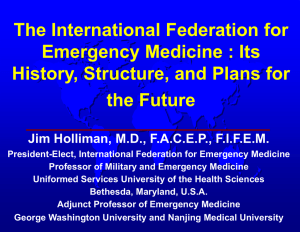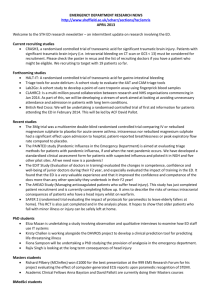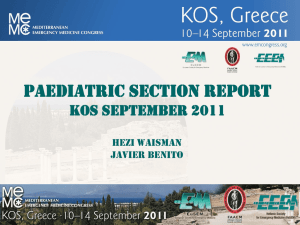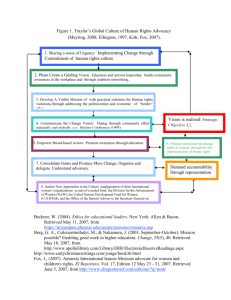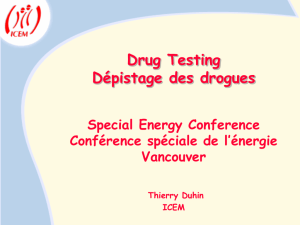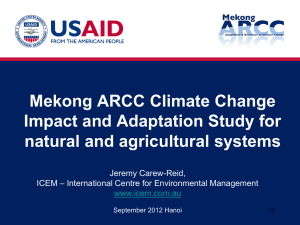(IFEM) : Its History, Structure, and Plans : Lecture Goals Present the
advertisement
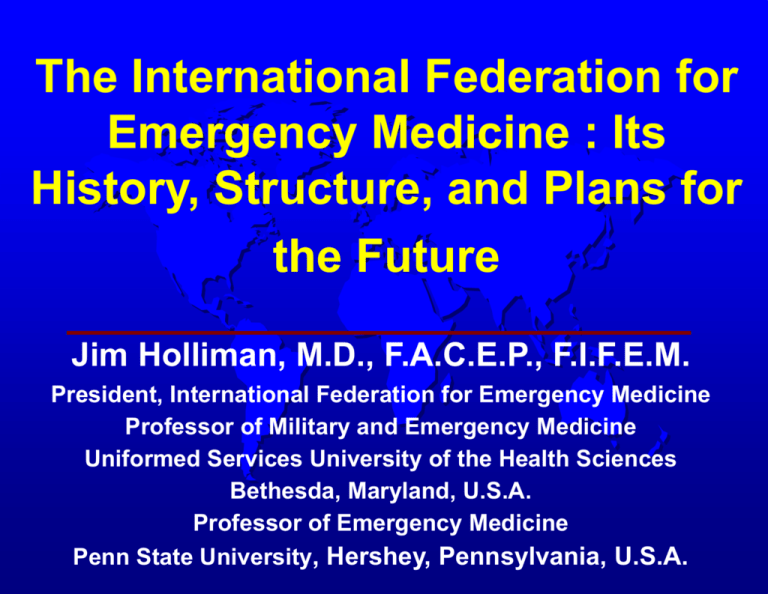
The International Federation for Emergency Medicine : Its History, Structure, and Plans for the Future Jim Holliman, M.D., F.A.C.E.P., F.I.F.E.M. President, International Federation for Emergency Medicine Professor of Military and Emergency Medicine Uniformed Services University of the Health Sciences Bethesda, Maryland, U.S.A. Professor of Emergency Medicine Penn State University, Hershey, Pennsylvania, U.S.A. The International Federation for Emergency Medicine (IFEM) : Its History, Structure, and Plans : Lecture Goals Present the historical background of the development of IFEM and its accomplishments to date Describe the current structure and operations of IFEM Present IFEM’s plans for future activities Encourage participation in IFEM activities Origins of IFEM • Started in the late 1980’s as a consortium between the British Association of Accident and Emergency Medicine (BAEM), the American College of Emergency Physicians (ACEP), the Canadian Association of Emergency Physicians (CAEP), and the Australasian College of Emergency Medicine (ACEM) (representing Australia and New Zealand) • Its original main activity was just conducting the International Conference on Emergency Medicine (ICEM) every 2 years – First ICEM held in London, United Kingdom (U.K.) • In 1986 Early History of IFEM’s ICEM • The IFEM founding organizations agreed to rotate the location of the ICEM every two years in the sequence : United Kingdom, Australia, Canada, United States, and then repeat the cycle • The host country national EM organization was responsible for organizing the ICEM in its country • The IFEM Presidency rotated to the President of the current ICEM host country EM organization Change in Philosophy for IFEM • In the mid 1990’s the IFEM leadership decided to open up membership in the IFEM to other countries’ EM organizations (in addition to the original 4 Founding Member Organizations) • Later it was decided that any IFEM member organization could apply to host the ICEM (so it would not just continue to rotate between the original 4 Founding Member countries) – First ICEM held “outside” the original 4 countries was in Singapore in 2010 Categories of Membership in IFEM • Founding Members : BAEM (now the Royal College of Emergency Medicine (UK) ), ACEP, CAEP, ACEM • Full Members : EM organizations which are the “leading national EM organization in a country which recognizes EM as a specialty and has at least one EM specialist training program” • Affiliate Members : Other national EM organizations in a country already represented by a Founding or Full Member or in a country where EM is not recognized or no residency training programs yet exist • Ex-officio Members : other multinational or regional EM organizations Note that Affiliate and Ex-officio Members do not have voting privileges IFEM’s Early Years Structure • IFEM President was the President of the host country organization for the ICEM • Board of Directors (BOD) members were the Presidents of the Founding and Full Members Organizations • The IFEM Executive (acting as a leadership committee) positions were elected from the BOD members (Secretary, Treasurer, Member at Large) • BOD meetings were held at ACEP’s Annual Scientific Assembly and at each ICEM Further Changes in IFEM’s Philosophy and Activities • In the 2000’s the IFEM leadership decided the organization should do more than just operate the ICEM and should become more of a “service organization” and undertake major activities to assist its members and other countries which do not yet have good EM services with EM and EMS development • The general goal was for IFEM to become the world’s premier organization for EM development and promotion Background for IFEM’s Recent Structural Changes • As the number of members of IFEM grew to more than 30, the BOD meetings became unwieldy and there was a feeling that there should be more regional representation and input at the Executive level in IFEM • Also as IFEM developed sources of revenue and complexity of operations it was felt necessary to incorporate the organization • So starting in 2005 a multi-year Bylaws revision process was undertaken • New tripartite structure took effect in 2012 Current IFEM “Three Level” Structure • Executive : President, President-Elect or Past-President, VicePresident, Treasurer, Secretary, Member at Large (representative from the Planning Committee for the next ICEM) • BOD : all the members of the Executive plus 6 regional representatives (Africa, Asia, Australasia, Central / South America, Europe, North America) • Assembly : Representatives from the Founding, Full, Affiliate, and Ex-officio members (now total > 60) • Executive and BOD have periodic phone conferences and all 3 levels have face to face meetings at the ICEM and ACEP’s Annual Scientific Assembly Should IFEM Have Individual Members ? • This has been extensively debated by the IFEM leadership • Idea behind this would be to have IFEM membership be available to EM physicians in countries that don’t yet have an EM organization • But it was decided that having individual memberships might decrease participation in national EM organizations • Individuals can currently be represented in IFEM through the Ex-officio regional society members of IFEM (the Latin American, African, Asian, and European Societies) IFEM’s Designation of Committees to Carry Out EM Development Efforts • • • • • • • • • Finance Governance Core Curriculum and Education Clinical Practice Specialty Implementation Continuing Professional Development Research Communications ICEM Site Selection Sub-committee IFEM’s Designation of Task Forces and Special Interest Groups to Carry Out Focused EM Development Efforts • • • • • • • • • • • Standard Terminology Task Force Access and Availability Task Force Global EM History Book Project Disaster Medicine Special Interest Group Pediatric Emergency Medicine Special Interest Group Emergency Ultrasound Special Interest Group Triage Special Interest Group Gender Issues Special Interest Group Sustainability Task Force Efficacy of Emergency Medicine Taskforce (proposed) International Residents Association Activities of the IFEM Finance Committee • Monitor and report income (IFEM’s main income is from a per capita fee for each attendee at the ICEM and from membership dues) • Maintain and dispense IFEM funds from a bank account in Australia • Develop new sources of income for IFEM Activities of the IFEM Governance Committee • Much of the work of this committee was completed in 2012 with the institution of the new Bylaws structure for IFEM • Provides ongoing review of the IFEM Bylaws and maintains consistency of wording between the IFEM Bylaws and the IFEM Constitution (for reasons of convenience and finances, IFEM has been registered and incorporated in Australia) Activities of the IFEM Core Curriculum and Education Committee • Published in multiple journals a standardized international curriculum for medical student training in EM and a curriculum for residency training in EM • Is working on writing a standardized international curriculum for paramedic training • Has submitted for publication a standardized curriculum for continuing professional development for EM physicians in practice • Has prepared a manuscript on “Mapping the EM Curriculum to Assessment Methods” • Collaborating with the Royal College of EM (UK) on its learning resource platform IFEM’s Medical Student Curriculum Published on the IFEM Web Site International Federation for Emergency Medicine INTERNATIONAL FEDERATION FOR EMERGENCY MEDICINE MODEL CURRICULUM FOR EMERGENCY MEDICINE Cherri Hobgood, MD,1 Venkataraman Anantharaman,MD,2 Glen Bandiera, MD,3 Peter Cameron, MD,4 Pinchas Halperin, MD,5 Nicholas Jouriles, MD,6 Darren Kilroy, MD,7 Terrence Mulligan, MD,8 Andrew Singer, MD,9 for the International Federation for Emergency Medicine Cherri Hobgood, University of North Carolina School of Medicine, Chapel Hill, NC, USA 2Venkataraman Anantharaman, Singapore General Hospital, Singapore, Singapore 3Glen Bandiera, University of Toronto, Toronto, ON, Canada 4Peter Cameron, MD 5Pinchas Halperin, Tel Aviv Medical Center, Tel Aviv, Israel 6Nicholas Jouriles, Akron General Medical Center, Akron, Ohio, USA 7Darren Kilroy, College of Emergency Medicine, London, United Kingdom 8Terrence Mulligan, Erasmus University School of Medicine, Rotterdam, The Netherlands 9Andrew Singer, Canberra Hospital, Woden, Australia CONTACT INFORMATION: Cherri Hobgood, MD, Associate Professor, Associate Chair, Department of Emergency Medicine, UNC School of Medicine, CB 7594, UNC Hospitals, Chapel Hill, NC 27599; 919-966-6442; hobgood@med.unc.edu RUNNING HEAD: IFEM Model Curriculum KEY WORDS: curriculum, international emergency medicine, medical education, WORD COUNT: 2372 IFEM UGE IFEM’s Postgraduate (C.P.D.) Curriculum • “IFEM Model Curriculum for Continuing Professional Development”, Hobgood C et al., submitted to the Canadian Journal of EM (CJEM) June 2014. Activities of the IFEM Clinical Practice Committee • Its Pediatric Standards Special Interest Group produced the widely acclaimed document “International Standards of Care for Children” which is on the IFEM web site • Its Ultrasound Special Interest Group developed a standardized international curriculum for point of care ultrasound training which has been submitted to CJEM for publication • Partnering with the Guidelines International Network to make more international clinical care guidelines openly available • Endorsed collaborative activities connected with “World Sepsis Day” • Cooperating with the Specialty Implementation Committee in accumulating and posting on line web resources Activities of the IFEM Specialty Implementation Committee • Conducted a Needs and Resources Assessment survey of the IFEM membership • Has posted a number of open access lectures as references on the IFEM web site • Is collaborating with the Clinical Practice Committee to accumulate, categorize, and post a listing of useful EM web sites on the IFEM web site • Has published in the African Journal of EM a manuscript on “How to Start and Operate a National EM Specialty Organization” (the full manuscript is also available on the IFEM web site) Activities of the IFEM Continuing Professional Development Committee • Supervises the ICEM Site Selection Sub-committee • Updated the IFEM Guidelines on operation of the ICEM, and on operation of IFEM endorsed “satellite” symposia, and on IFEM endorsement of other EM conferences • Collaborating with the Core Curriculum Committee on the Standardized Recommendations for Postgraduate CPD manuscript Activities of the IFEM Research Committee • Decided that IFEM should not formally affiliate with any existing EM journal at this time • Is working on identifying research content experts and their areas of research expertise by country, and on identifying current research networks • Developing criteria for handing requests for research network endorsements • Identifying current educational modules on research techniques which could be made openly available on-line • Published a statement on ethical standards Activities of the IFEM Site Selection for the ICEM Sub-committee • Review the applications by different IFEM member organizations to host an upcoming ICEM • Has sub-committee members from the planning committees for the last and the next ICEM • Assesses the strengths of each application relative to the scientific and educational content of the proposed program, the tourism attractiveness of the proposed venue, and the ability of the hosting organization to have the financial and personnel resources to conduct the ICEM Activities of the IFEM Standard Terminology Task Force • Has conducted a multiple round survey of the IFEM membership on EM terminology and achieved a high degree of agreement on the definitions of key terms in EM • Submitted a manuscript of the definitions list to Annals of EM July 2014 Activities of the IFEM Access and Availability Task Force • Conducted an international pilot survey on the degree of access to EM services in different countries and is developing a journal manuscript with the survey results • Is working on developing sources of funding for larger studies of EM access and availability • One of the Task Force members, Dr. Gautam Bodiwala of the U.K., has served as IFEM’s representative to the World Health Organization’s Trauma Care Committee Activities of the IFEM Global EM History Book Project • Decided on a general content and preliminary chapter list for a book on the history of EM globally • Is identifying specific persons to author chapters in the book (many of the chapters are about the history of EM development in single countries) Activities of the IFEM Disaster Medicine Special Interest Group • Collaborate with the World Association of Disaster and Emergency Medicine and other disaster-related organizations in developing disaster management training resources and in participating in international conferences • Develop presentations on disaster management for the upcoming ICEM’s • Serve as an information resource on disaster management for IFEM members • Accumulate educational resources on disaster management for IFEM’s web site The IFEM Framework for Quality and Safety in the Emergency Department • Is a highly regarded consensus document outlining the key components of safe, high quality care in the Emergency Department • Produced from the Proceedings of the IFEM “Quality and Safety in Emergency Care Symposium” held in the U.K. in November 2011 • Reviewed in a plenary session at the ICEM in Dublin, Ireland in June 2012 IFEM’s Current Office Structure • IFEM “Secretariat” is located in ACEM’s office in Melbourne, Australia • ACEM provides office and one half time employee staff support • IFEM is incorporated and registered under Australian law, but effectively is independent of Australia • ACEP and CAEP also provides staff support for some committees IFEM’s Current Officers of the Executive • • • • • • • • Executive Officer : Carol Reardon President : Dr. Jim Holliman (ACEP) President-elect : Dr. Lee Wallis (EMSSA) Past-president : Dr. Peter Cameron (ACEM) Vice-president : Dr. Jim DuCharme (CAEP) Treasurer : Dr. Andrew Singer (ACEM) Secretary : Dr. Robert Schafermeyer (ACEP) Member at Large : Dr. Melanie Stander (EMSSA) Current Regional Representatives on the IFEM BOD • • • • Africa : Dr Melanie Stander (EMSSA) Asia : Dr. Kang Hyun Lee (Korea SEM) Australasia : Dr. Anthony Cross (ACEM) Central and South America : Dr. Edgardo Menendez (SAE) • Europe : Dr. Juliusz Jakubaszko (PSEM) • North America : Dr. Terry Mulligan (ACEP, ACOEP) Map of Current IFEM Members (pink are founding and full members, and gray-green are affiliate members) Countries Currently Represented as IFEM Founding or Full Members U.S.A., Colombia, Panama, Australia, Bahrain, Canada, China, U.K., Turkey, South Africa, Hong Kong, Hungary, Ireland, Israel, Korea, Malaysia, Netherlands, Poland, Argentina, Dominican Republic, Mexico, Peru, Venezuela, India, Singapore, South Pacific, Sweden, Taiwan, Thailand, Trinidad / Tobago, Tunisia, Uzbekistan, Costa Rica, Philippines, Iran, Chile, Iraq, Cuba, Emirates, Georgia, Vietnam, Tanzania, Yemen, and Japan Countries Currently Represented by Affiliate Members of IFEM U.S.A. : AAEM, ACOEP, SAEM, EMRA Turkey, Panama, Madagascar, Brazil, Denmark, Germany, Lebanon, Pakistan, Spain, Sri Lanka, Malaysia, Libya, Switzerland Countries Currently Represented by Affiliate Members of IFEM • U.S.A. : AAEM, ACOEP, SAEM, EMRA • Turkey, Panama, Madagascar, Brazil, Denmark, Germany, Lebanon, Pakistan, Spain, Sri Lanka, Malaysia Countries with Current or Recent Applications to Join IFEM • • • • • Finland Ethiopia Oman Ecuador Mexican Association of Pediatric Emergency Medicine • Saudi Arabia • Nigeria Current IFEM Ex-officio Members • • • • • African Federation for EM Asian Society for EM ALACED (Latin America) European Society of EM (EuSEM) Pan American Collaborative EM Development Program (PACEMD) IFEM Endorsed International Conferences • Symposium on Resuscitation in Mexico, June 2011 • Symposium on Quality and Safety in Emergency Care in the U.K., November 2011 • 8th and 9th New York City International Conferences on EM, New York City, August 2011 and August 2012 Upcoming ICEM’s (ICEM’s will be held every year starting in 2019) Cape Town, South Africa : April 18 to 21, 2016 • 2018 : Mexico City, Mexico • 2019 : Seoul, South Korea • 2020 : Buenos Aires, Argentina • 2021 : Announced October 2015 Summary of IFEM’s Activities Related to Developing E.M. Training Globally • Published standardized curricula – Medical student, residency, and Continuing Professional Development (post-residency) • Conducting the I.C.E.M. • Web site open access posting of lectures and documents • Consensus manuscripts from the various IFEM committees • Collaborating with SAEM / GEMA and the ACEP International Section in their international training efforts Educational Value of the 2014 I.C.E.M. in Hong Kong • 10 preconference workshops • 6 plenary lectures • 10 simultaneous tracks with 100 topic sessions, 323 presentations • 260 speakers • 144 oral abstracts, 555 posters • 4 tracks presented in Chinese • 2287 attendees from 66 countries IFEM Awards • “Fellow of the IFEM” – Several nominees every 2 years from any IFEM member ; for service to IFEM or international EM work • “Gautam Bodiwala Lifetime Leadership Achievement Award” first awarded in 2014 • “Humanitarian Award” – 1 to 2 every 2 years for humanitarian work • “Campbell McFarlane Award” – For best presentation at ICEM Current Challenges for IFEM • Obtaining more funding and expanding its office and support capabilities • Perhaps some competition with other international organizations such as WADEM • Improving relations and collaborations with the regional EM organizations such as EuSEM • Getting more countries to develop national EM societies and then join IFEM Proposed New Undertakings for IFEM Related to E.M. Training • Core Curriculum and CPD Committees to develop IFEM endorsed educational podcasts, satellite symposia, preconference workshops, and focused single topic conferences • Support development of regional transnational E.M. board certification – Latin America, Europe, Asia, Africa Potential Broad Future Activities and Goals for IFEM • With World Health Organization collaboration, establishing and maintaining high quality EM in all countries • Standardizing transnational clinical care and EM training protocols • Using EM to contribute to peace and stability How Can You Interact with IFEM ? • Volunteer for, and get appointed to, an IFEM committee, task force, or special interest group • Attend the ICEM • Attend the multiple IFEM meetings held at ACEP Scientific Assembly each fall • Help a country you are working in to develop a national society of EM and then have that organization join IFEM IFEM Contact Information Carol Reardon, Executive Director International Federation for Emergency Medicine 34 Jeffcott Street West Melbourne, VIC 3003, Australia Phone 61-407-042-543, fax 61-(03)- 9320-0400 Emails : ifem@acem.org.au . Website : http://www.ifem.cc IFEM’s History, Structure, and Plans : Lecture Summary IFEM has grown from an original organization representing just 5 countries to now representing more than 60 IFEM’s International Conference on EM held every two years has been very successful IFEM is involved in multiple efforts at EM specialty support and development worldwide There is huge opportunity for further collaboration of EM physicians and organizations with IFEM

